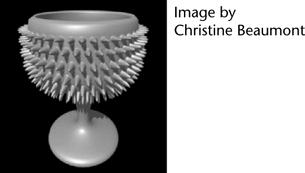Show in Contents

Add to Favorites

Home: Autodesk Maya Online Help

Bump maps

Surface Relief

Feature-based displacement

Displacement maps
Displacement maps are grayscale
textures you map to objects to create true surface relief (elevations
and depressions) on an otherwise flat object.
With Displacement maps,
depressions and elevations become part of the geometry of the object,
changing the topology, unlike Bump maps
that only create the illusion of surface relief.
Note
- Because displacement changes the geometry
of an object, displacement mapped objects usually require further
tessellation (more triangles, which the renderer uses to approximate
the smoothness of the surface). By default, Maya uses
Feature-based displacement mapping
to automatically add more triangles where required.
- File textures that are used for displacement
mapping are usually connected via their outAlpha attribute.
If the corresponding texture image file does not provide an alpha
channel, then the displacement effect may be missing when using
certain image formats. To avoid this, turn on the Alpha
is Luminance attribute in the Color Balance section
of the File Texture node. For more
information, see
File.
Displacement maps move
an object’s vertices. By default, the height of the displacement
is determined by the Alpha Gain value in the displacement map’s Attribute
Editor. If you turn on Alpha is Luminance,
the height result is based on the intensity of the pixels instead.
Use
displacement maps to create shallow or deep surface relief. For
example, you can create embossing, mountain peaks and valleys, spikes,
and so on.
Because Displacement maps
create true surface relief, they:
- can cast or receive shadows
- can be seen if you silhouette the object
- take more time to render than bump maps,
which create the illusion of surface relief
NoteYou can connect a
texture as a displacement map by connecting it to the
Displacement
mat attribute in the material’s shading group. See
Connect a texture as a displacement map for
more information.
Displacement Bounding Box
Because
displacement mapping changes the volume of an object, it’s bounding
box may become too small or too large.
Bounding boxes, which
represent the bounding volume of an object, can be used to speed
up Maya operations and can make a significant difference for complex
models.
See
Change bounding box scale.
